托尼·莫里森《宠儿》读书报告(英文)
- 格式:doc
- 大小:28.00 KB
- 文档页数:4
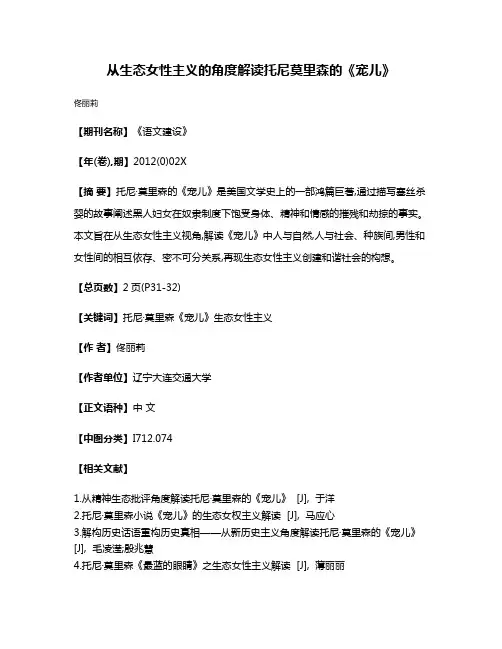
从生态女性主义的角度解读托尼莫里森的《宠儿》
佟丽莉
【期刊名称】《语文建设》
【年(卷),期】2012(0)02X
【摘要】托尼·莫里森的《宠儿》是美国文学史上的一部鸿篇巨著,通过描写塞丝杀婴的故事阐述黑人妇女在奴隶制度下饱受身体、精神和情感的摧残和劫掠的事实。
本文旨在从生态女性主义视角,解读《宠儿》中人与自然,人与社会、种族间,男性和女性间的相互依存、密不可分关系,再现生态女性主义创建和谐社会的构想。
【总页数】2页(P31-32)
【关键词】托尼·莫里森《宠儿》生态女性主义
【作者】佟丽莉
【作者单位】辽宁大连交通大学
【正文语种】中文
【中图分类】I712.074
【相关文献】
1.从精神生态批评角度解读托尼·莫里森的《宠儿》 [J], 于洋
2.托尼·莫里森小说《宠儿》的生态女权主义解读 [J], 马应心
3.解构历史话语重构历史真相——从新历史主义角度解读托尼·莫里森的《宠儿》[J], 毛凌滢;殷兆慧
4.托尼·莫里森《最蓝的眼睛》之生态女性主义解读 [J], 薄丽丽
5.托尼·莫里森作品中的生态女性主义解读——以《最蓝的眼睛》和《所罗门之歌》为例 [J], 崔东琦
因版权原因,仅展示原文概要,查看原文内容请购买。
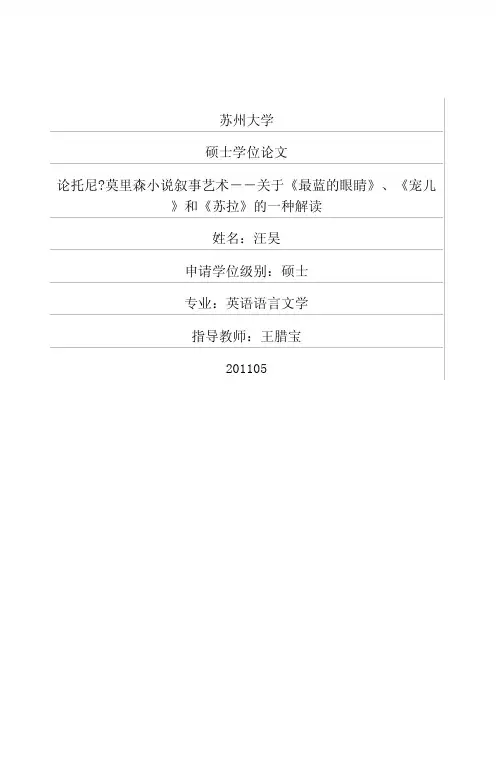
苏州大学硕士学位论文论托尼?莫里森小说叙事艺术--关于《最蓝的眼睛》、《宠儿》和《苏拉》的一种解读姓名:***申请学位级别:硕士专业:英语语言文学指导教师:***201105摘要托尼·莫里森(1931一)是20世纪最为杰出的非裔美国女作家,因其卓越的创作才华于1993年获诺贝尔文学奖,是第一位也是唯一一位获此殊荣的美国黑人女性。
作为一名才华横溢的作家,莫里森是一位叙事艺术的大师。
在其创作的小说中,她总能成功地选择并运用最恰当的写作手法来服务小说的主题。
本论文选择莫里森的三部小说《最蓝的眼睛》、《宠儿》和《苏拉》来研究该作家如何运用不同的叙事技巧来深化小说的主题。
本论文分五章。
第一章简要介绍莫里森生平成就以及其三部作品,即《最蓝的眼睛》、《宠儿》和《苏拉》。
第二章主要分析莫里森在《最蓝的眼睛》中运用的多重叙述声音及人物故事对比等手法,说明小说家如何通过特定的叙事手法表明审美标准本应是多元的一少部分黑人内化白人标准是极其有害的。
第三章讨论莫里森在《宠儿》中运用的哥特式叙事以及内心独白等手法,说明小说如何运用这些手法揭示黑人在惨绝人寰的奴隶制下扭曲的心灵,并且指出只有当黑人相互袒露心灵才能治愈伤害。
第四章讨论小说《秀拉》中运用环形叙述和反讽等手法,说明小说家如何运用这些手法叙述一个叛逆的黑人女性成为黑人社区不可或缺的关键人物的故事。
最后一章为结论,对以上章节所讨论的写作手法进行总结,说明在莫里森自己的小说中总能通过将叙述手法与小说主题有机结合起来,使叙事艺术很好地服务于小说的主题。
关键词:托尼·莫罩森,《最蓝的眼睛》,《宠儿》,《苏拉》,叙事艺术。
叙事策略AbstractToniMorrison(1931-)isthemostprominentandsuccessfulAfricanAmericanwomanwriterofthe20thcentury.ShereceivedtheNobelPrizeforliteraturein1993forherexcellentachievementsinwriting,andhasremainedthefirstandonlyAfricanAmericanwomantowinthisaward.Asagiftedwfiter’Morrisonisamasterwiththeartofnarration.Inhernovels,sheunfailinglyemployswritingtechniquesthatbestservehermessage.Inthisthesis,Itakealookatthreeofhernovels,namely,TheBluesteye,BelovedandSula,andexaminethewayinwhichMorrisonUSeSdifferentnarrativedevicestofacilitatethecommunicationofherthemes.Thisthesisisdividedintofivechapters.ChapterOneistheintroduction,whichincludesabriefsurveyofToniMorrison’Swritingcareerandherthreebooks,TheBluesteye,SulaandBeloved.ChapterTwoanalyzestwonarrativetechniquesusedinTheBluesteye.Theyaretheuseofmultiplenarrativeperspectivesandthepresentationofcontrastinglifestoriesinthenovel.Byemployingthesetwonarrativetechniques,Morrisonindicatesthestandardofbeautyshouldbedifferentindifferentpeople’Seyes.Itisharmfulforblackpeopletointernalizewhitebeautyastheonlystandard.ChapterThreediscussesthetwonarrativetechniquesinBeloved.ByemployingtheGothicmodeofnarrationandtheinteriormonologue,Morrisonshowsreadersthedistortedpersonalityandtraumatizedheartsofblackpeoplebroughtbyslavery.AndMorrisonalsoindicatesthatonlywhenblackpeopleopentheirheartstoeachotherCantheyfindtrueloveandhavetheirspirit"saved.ChapterFourgivesasurveyofthenarrativetechniquesexploitedinSula,whicharecenteredaroundtheuseofcircularstructureandirony.Byemployingthesetwonarrativetechniques,MorrisonshowsUSthatarebelliousblackwomancanbesupportivetohercommunityatthemostimpossibletimes.Throughirony,Morrisonalsoreinforcesthethemeofthenovel,whichis:appearancescallbedeceptive.ThelastchapteristheconclusioninwhichIcontendMorrisonisanarrativeartistwhosenovelsstandconsistentlyasacombinationofnarrativetechniquesandthematiccontents.AndIbelievethatthisresearchwillhelpnotonlytodeepenourunderstandingandappreciationofMorrison’Sfiction,butalsotosuggestanewwayofstudyinghernovels.Words:TolliMorrison,TheBluesteye,Beloved,Sula,artofnarration,narrativeKeystratigiesAcknowledgementsItisimpossibleformetocompletemystudyasanMAcandidateatSoochowUniversitywithoutthehelpofmanypeople.WangLabao,isthemostimportantAmongthosepeople,mysupervisor,Professorone.Hisconstantencouragementhasnourishedmeinmystudy.Hisinstructionandeachstageofthewritingprocesshavehonedmyresearchskills·Asastrictguidanceatmentoranddevotedscholar,hehassetagoodexampleformeandtaughtmethingsnotlimitedtoliteratureonly.1wishtoextendmysincerethankstohimforallthathehasdoneforme.MygratitudealsogoestOProfessorZhuXinfu,ProfessorXuQinggenandProfessormewithaclearandsystematicHongQingfuwhohavehelpedbyequippingitistostudyEnglishandAmericanliterature.PreciousadviceunderstandingofwhatfromProfessorZhuXingfuinparticularhasbenefitedmeimmeasurably.AndIammesomuchgratefultoProfessorSongYanfangwhosethought-provokinglecturestaughtaboutliterarytheory.Thewritingprocesswouldbemorechallenginghaditnotbeenfortheunfailingfrommygoodfriends.AndIalsowishtothankmyfamilyforunderstandingandsupporttheirunswervingconfidenceinmeandunconditionallove.ChapterOneIntroductionChloeAnthonyWofford,laterknownasToniMorrison,wasborninLorain,Ohio,onFebruary18,1931.Shewasthedaughterofashipyardwelderandareligiouswomanwhosanginthechurchchok.MorrisonhadasisterLoisandtwoyoungerbrothers,GeorgeandRaymond.HerparentshadmovedtoOhiofromtheSouth,hopingtoraisetheirchildreninallenvironmentfriendliertoblacks.DespitethemovetotheNorth,theWoffordhouseholdwassteepedintheoraltraditionsofSouthernAfricanAmericanandstoriesofChloeWofford’Schildhoodundoubtedlycommunities.Thesongsinfluencedherlaterwork;indeed,ToniMorrison’SoeuvredrawsheavilyupontheoralartformsofAfricanAmericans.AlthoughToniMorrison’Swritingisnotautobiographical,shefondlyalludestoherpast,”Mybeginningsarealwaysthere…Nomatterwhat1write,Ibeginthere….It’Sthematrixforme….Ohioalsooffersanescapefromstereotypedblacksettings.Itisneitherplantationnorghetto."(Watkins,1994:20)ToniMorrison’Swritingwasalsogreatlyinfluencedbyherfamily.HergrandparentshadrelocatedtoOhioduringthenationalmovementofblacksoutoftheSouthknownastheGreatMigration.Hermother’Sparents,AredeliaandJohnSolomonWillis,afterleavingtheirfarminAlabama,movedtoKentucky,andthentoOhio.Theyplacedextremevalueintheeducationoftheirchildrenandthemselves.JohnWillismughthimselftoreadandhisstoriesbecameinspirationforMorrison’S跖愕ofSoloman(1977).ChloeWoffordwasanextremelygiftedstudent,learningtoreadatallearlyageanddoingwellatherstudiesatanintegratedsch001.Morrison,whoattendedHawthorneElementarySchool,wastheonlyAfricanAmericaninher1stgradeclassroom.Shewasalsotheonlystudentwhobeganschoolwiththeabilitytoread.BecauseshewasSOaskedtohelpotherstudentslearntoread.Shefrequentlyworkedskilled,shewasoftenwiththechildrenofnewimmigrantstoAmerica.1ChloeWofford’Sparents’desiretOprotecttheirchildfromtheracistenvironmentoftheSouthsucceededinmanyrespects:racialprejudicewaslessofaprobleminLorain,Ohio,thanitwouldhavebeenintheSouth,andChloeWoffordplayedwitharaciallydiversegroupoffriendswhenshewasyoung.Inevitably,however,shebegantoexperienceracialdiscriminationassheandherpeersgrewolder.Shegraduatedwithhonorsin1949andwenttoHowardUniversityinWashingtonD.C.AtHoward,shemajoredinEnglishandminoredinclassics,andwasactivelyinvolvedintheaterartsthroughtheHowardUniversityPlayers.ShegraduatedfromHowardin1953withaB.A.inEnglishandanewname:ToniWofford(Tonibeingashortenedversionofhermiddlename).ShewentontoreceiveherM.A.inEnglishfromCornellin1955.AfterteachingforsometimeatTexasSouthernUniversity,shereturnedtoHowardUniversityandmetHaroldMorrison.Theymarried,andbeforetheirdivorcein1964,ToniandHaroldMorrisonhadtwosoils.Itwasalsoduringthistimethatshewrotetheshortstorythatwouldbek:omethebasisforherfirstnovel,TheBluesteye.In1964,shetookajobinSyracuse,NewYork,asanassociateeditoratRandomHouse.Theresheraisedhersonsasasinglemom,andcontinuedtOwritefiction.In1967,shereceivedapromotiontosenioreditorandgotamuch-desiredtransfertONewYorkCity.TheBluestEyewaspublishedin1970.Thestoryofayounggirlwholoseshermind,thenovelwaswellreceivedbycriticsbutfailedcommercially.Between1971and1972,MorrisonworkedasaprofessorofEnglishfortheStateUniversityofNewYorkatPurchasewhileholdingherjobatRandomHouseandworkingonSula,anovelaboutadefiantwomanandherrelationswithotherblackfemales.Sulawaspublishedin1973.Theyears1976and1977sawMorrisonworkingasavisitinglectureratYaleandworkingonhernextnovel,SongofSolomon.Thisnextnoveldealtmorefullywithblackmalecharacters.AswithSula,Morrisonwrotethenovelwhileholdingateachingposition,continuingherworkasaneditorforRandomHouse,andraisinghertwosons.SongofSolomonwaspublishedin1977andenjoyedbothcommercialandcritic,.al。
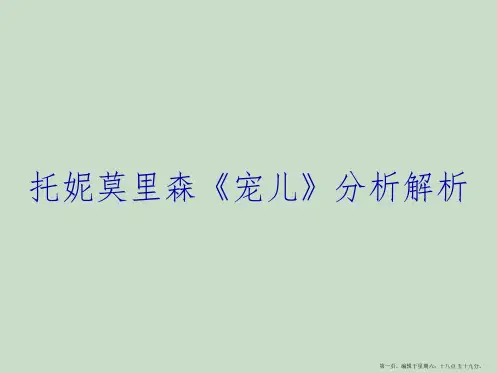

读书笔记3000字精选9篇英文回答:Reading is one of my favorite hobbies, and I always make sure to take notes while reading to help me remember important points and quotes. Here are 9 selected book notes that I have compiled:1. "To Kill a Mockingbird" by Harper Lee.This classic novel explores themes of racism and injustice in the American South. One of the most memorable quotes from the book is "You never really understand a person until you consider things from his point of view...until you climb into his skin and walk around in it."2. "1984" by George Orwell.This dystopian novel paints a bleak picture of atotalitarian society where freedom is nonexistent. One of the most chilling quotes from the book is "Big Brother is watching you," which serves as a warning about the dangers of surveillance and government control.3. "The Great Gatsby" by F. Scott Fitzgerald.This novel captures the glamour and excess of the Jazz Age in America. One of the most famous quotes from the book is "So we beat on, boats against the current, borne back ceaselessly into the past," which reflects the idea of striving for a better future while being weighed down by the past.4. "Pride and Prejudice" by Jane Austen.This classic romance novel explores themes of love, class, and social expectations. One of the most iconiclines from the book is "It is a truth universally acknowledged, that a single man in possession of a good fortune, must be in want of a wife," which sets the tonefor the story.5. "The Catcher in the Rye" by J.D. Salinger.This coming-of-age novel follows the rebellious teenager Holden Caulfield as he navigates the challenges of growing up. One of the most memorable quotes from the book is "I'm quite illiterate, but I read a lot," which captures Holden's complex character and his struggles with phoniness in the adult world.6. "To the Lighthouse" by Virginia Woolf.This modernist novel explores themes of time, memory, and the complexities of human relationships. One of the most poignant quotes from the book is "What is the meaning of life? That was all—a simple question; one that tended to close in on one with years, the great revelation had never come. The great revelation perhaps never did come. Instead, there were little daily miracles, illuminations, matches struck unexpectedly in the dark."7. "Beloved" by Toni Morrison.This powerful novel tells the story of Sethe, a former slave haunted by the memories of her past. One of the most haunting quotes from the book is "Definitions belong to the definers, not the defined," which speaks to the idea of reclaiming one's own identity and narrative.8. "The Road" by Cormac McCarthy.This post-apocalyptic novel follows a father and son as they journey through a devastated landscape. One of the most heartbreaking quotes from the book is "You forget what you want to remember, and you remember what you want to forget," which reflects the characters' struggle to hold on to their humanity in a harsh and unforgiving world.9. "The Alchemist" by Paulo Coelho.This inspirational novel follows the journey of a young shepherd named Santiago as he seeks his personal legend. One of the most uplifting quotes from the book is "And, when you want something, all the universe conspires inhelping you to achieve it," which encourages readers to pursue their dreams with determination and faith.中文回答:读书是我最喜欢的爱好之一,我总是在阅读时做笔记,以帮助我记住重要的观点和引用。
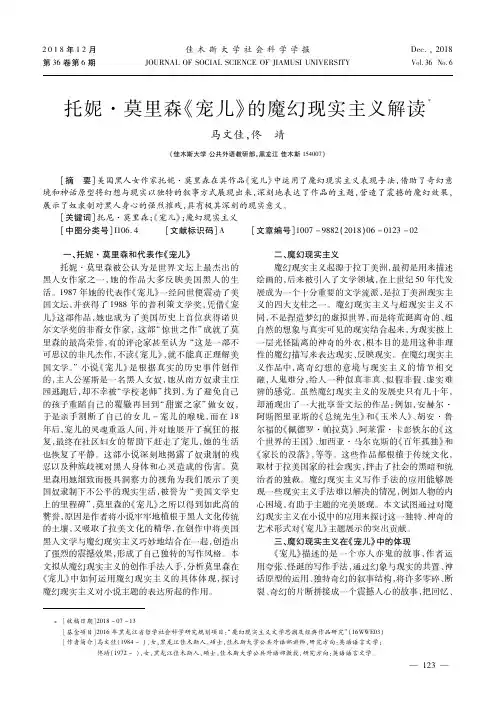
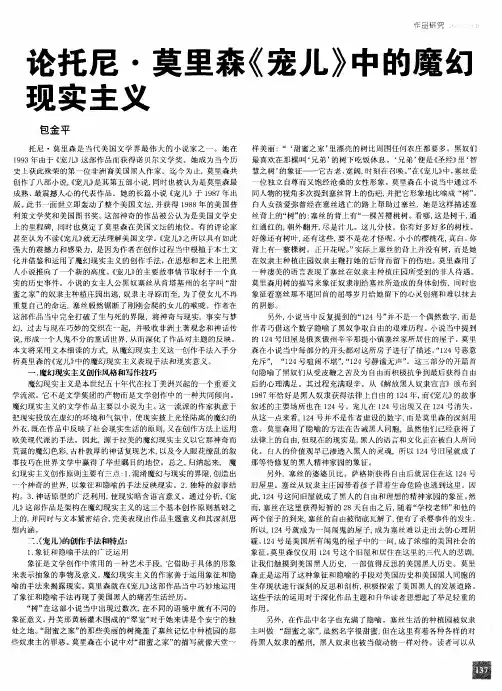
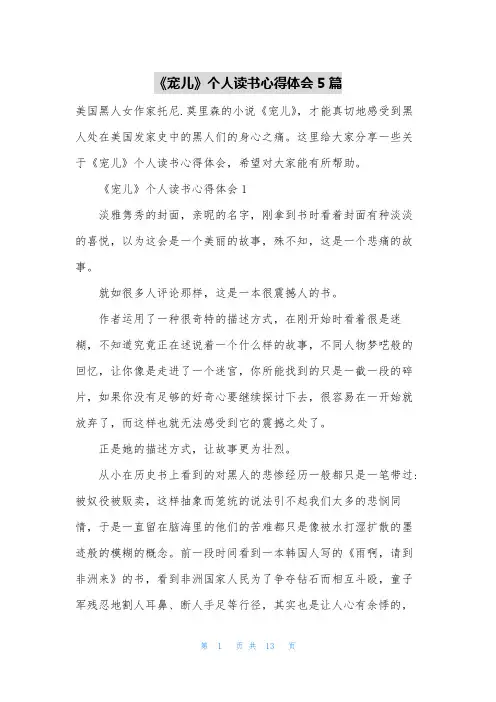
《宠儿》个人读书心得体会5篇美国黑人女作家托尼.莫里森的小说《宠儿》,才能真切地感受到黑人处在美国发家史中的黑人们的身心之痛。
这里给大家分享一些关于《宠儿》个人读书心得体会,希望对大家能有所帮助。
《宠儿》个人读书心得体会1淡雅隽秀的封面,亲昵的名字,刚拿到书时看着封面有种淡淡的喜悦,以为这会是一个美丽的故事,殊不知,这是一个悲痛的故事。
就如很多人评论那样,这是一本很震撼人的书。
作者运用了一种很奇特的描述方式,在刚开始时看着很是迷糊,不知道究竟正在述说着一个什么样的故事,不同人物梦呓般的回忆,让你像是走进了一个迷宫,你所能找到的只是一截一段的碎片,如果你没有足够的好奇心要继续探讨下去,很容易在一开始就放弃了,而这样也就无法感受到它的震撼之处了。
正是她的描述方式,让故事更为壮烈。
从小在历史书上看到的对黑人的悲惨经历一般都只是一笔带过:被奴役被贩卖,这样抽象而笼统的说法引不起我们太多的悲悯同情,于是一直留在脑海里的他们的苦难都只是像被水打湿扩散的墨迹般的模糊的概念。
前一段时间看到一本韩国人写的《雨啊,请到非洲来》的书,看到非洲国家人民为了争夺钻石而相互斗殴,童子军残忍地割人耳鼻、断人手足等行径,其实也是让人心有余悸的,很久都无法从她们的惨状里走出来,这是直观地通过眼睛看而从心底里产生的。
而在《宠儿》里,其实每一句话都是从她们不同人物里的心底流露出来的,她们的回忆,她们的渴望,她们所经历的一切,在作者的笔下,不只是文字间的组合,我似乎看到了每一个文字都是在战栗着的,在微微的叹息中向我们传达故事,所以,即使是通过眼睛看到的,眼睛在接触到文字的那一瞬间,眼睛就想要把情感直接展现出来了。
黑人们的经历让人后怕。
难以阐述我自己的感受,因为对比之下,我的悲悯是苍白的,无力的。
在如此巨大的悲痛面前,悲悯显得可笑,所有的情感都黯然失色。
但,除去了塞丝们的爱在那之中仍是鲜活的。
保罗说,你的爱太浓了。
是的,她们的爱都太过于浓烈了,因此所有的悲痛都可被遗忘,被忽略,当她们一次次地回忆那些不堪回首的岁月时,爱是使她们出走的唯一动力,为自由而搏动的脉搏。

《宠儿》液体意象文化隐喻研究作者:王润娟来源:《文教资料》2014年第20期摘要:托尼·莫里森的《宠儿》以丰富的液体意象,水、血、乳及其三位一体的独特现象隐喻了黑人在白人文化环境中艰难求生的过程。
作为奴隶,黑人被剥夺了自由和尊严。
液体意象隐喻了奴隶制经济模式的荒谬逻辑和残暴本质。
黑人及其文化被奴役、被割裂的历史和黑人向往自由、传承民族文化的决心在液体意象中得以凸显。
关键词:《宠儿》液体意象三位一体隐喻引言美国非裔女作家托尼·莫里森(Toni Morison,1931—)的小说《宠儿》(Beloved,1987)可谓是学界的宠儿。
众多流派都在这座宝藏中寻找支持自身理论的例证。
国内学者也从主题、叙事、人物、文化等角度对这篇小说进行过研究,也有学者的研究涉及小说中黑人姓名的隐喻意义[1]P65和鬼魂的隐喻意义[1]P153,但小说中的液体意象,即水、血、乳三位一体的独特现象所包含的文化隐喻意义似乎成了学术空白。
正如小盖茨所说:“黑人一开始就是隐喻大师:说一件事而意指另一件事。
这是在西方文化压抑中求生存的一种基本方式。
”[3]P200莫里森在《宠儿》中“以丰富、奇特的意象暴露出普通事物中的邪恶”[3]P195。
液体意象貌似普通,却暗含深意,它们是黑人在被剥夺了自由和尊严后在白人文化环境中艰难求生过程的反映,隐喻了黑人及其文化被奴役、被割裂的历史,和黑人向往自由、传承民族文化的决心。
一、水:奴役与自由在《宠儿》中,水具有丰富的隐喻意义。
首先,作为地理标志,水连接了非洲与美洲,连接了肯塔基州与俄亥俄州。
美国黑人的祖先作为奴隶被迫来到美国。
运奴船上,他们被剥夺了自由与尊严,谩骂、殴打、禁食、强奸无处不在。
“没有皮的男人给我们拿来他们的晨尿喝”,“给我们带来甜石头吮”,“死人的小山包好烫”,“没有皮的男人们用竿子把他们捅穿”。
[4]P267-268在《宠儿》的题献上,莫里森写道:“六千万甚至更多。
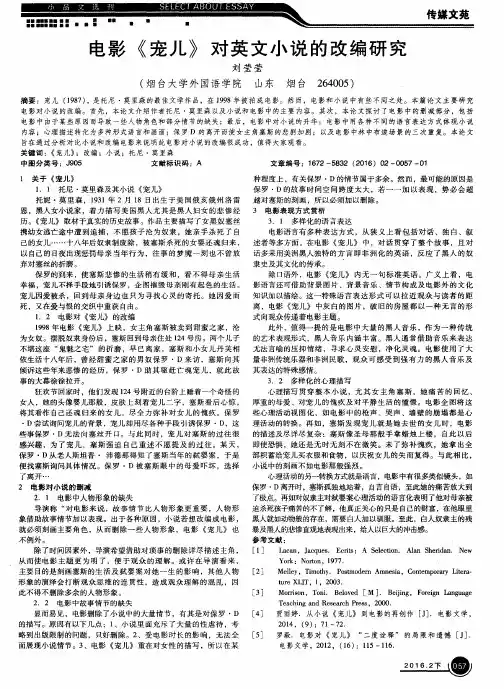
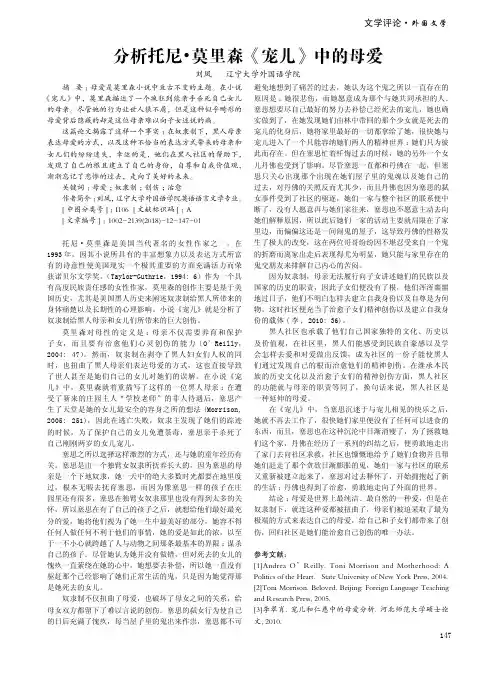
文学评论·外国文学分析托尼•莫里森《宠儿》中的母爱刘凤 辽宁大学外国语学院摘 要:母爱是莫里森小说中亘古不变的主题。
在小说《宠儿》中,莫里森描述了一个疯狂到能亲手杀死自己女儿的母亲。
尽管她的行为让世人很不屑,但是这种似乎畸形的母爱背后隐藏的却是这位母亲难以向子女述说的痛。
这篇论文揭露了这样一个事实:在奴隶制下,黑人母亲表达母爱的方式,以及这种不恰当的表达方式带来的母亲和女儿们的纷纷迷失,幸运的是,她们在黑人社区的帮助下,发现了自己的根且建立了自己的身份,自尊和自我价值观,渐渐忘记了悲惨的过去,走向了美好的未来。
关键词:母爱;奴隶制;创伤;治愈作者简介:刘凤,辽宁大学外国语学院英语语言文学专业。
[中图分类号]:I106 [文献标识码]:A[文章编号]:1002-2139(2018)-12-147-01托尼•莫里森是美国当代著名的女性作家之一。
在1993年,因其小说所具有的丰富想象力以及表达方式所富有的诗意性使美国现实一个极其重要的方面充满活力而荣获诺贝尔文学奖。
(Taylor-Guthrie,1994: 6)作为一个具有高度民族责任感的女性作家,莫里森的创作主要是基于美国历史,尤其是美国黑人历史来阐述奴隶制给黑人所带来的身体痛楚以及长期性的心理影响。
小说《宠儿》就是分析了奴隶制给黑人母亲和女儿们所带来的巨大创伤。
莫里森对母性的定义是:母亲不仅需要养育和保护子女,而且要有治愈他们心灵创伤的能力(O’Reilly,2004: 47)。
然而,奴隶制在剥夺了黑人妇女们人权的同时,也扭曲了黑人母亲们表达母爱的方式,这也直接导致了世人甚至是她们自己的女儿对她们的误解。
在小说《宠儿》中,莫里森就着重描写了这样的一位黑人母亲:在遭受了新来的庄园主人“学校老师”的非人待遇后,塞思产生了天堂是她的女儿最安全的容身之所的想法(Morrison, 2005: 251),因此在逃亡失败,奴隶主发现了她们的踪迹的时候,为了保护自己的女儿免遭荼毒,塞思亲手杀死了自己刚刚两岁的女儿宠儿。
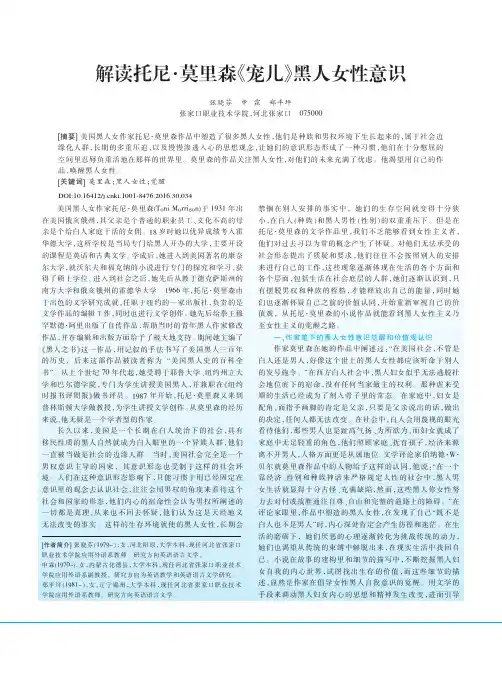
《宠儿》中的“叙述声音"与“话语权威"肖敦交(中南大学外国语学院,湖南长沙410075)摘要:西方叙事学在长期的批评实践中。
从不同角度切入作品。
积累了较为丰富的文本分析方法。
本文旨在通过研究托尼·莫里森(Toni M or r i son)的作品《宠儿》中的“叙事话语”.以结构主义批评和女性主义批评为参照,考察女性“叙事话语”,以及所实现的“话语权威”。
“话语”层面在国外文学研究中较易被忽略,希望本文的探讨能为外国文学研究。
特别是黑人女性文学研究提供某种有益的借鉴。
关键词:《宠儿》叙述声音话语权威引言话语.其实是一种有意义的声音。
在女性主义观念里,声音的发出与否有时关系到女性个体的生死存亡。
而从叙事学的角度来讲,声音是指叙事中讲叙者的话语.以区别于叙事中的作者和非叙述人物,专指文本实践中的具体形式。
罗杰·夫勒在《语言和控制》中说:“用语言描述时,要达到中立的地位是不可能的.因为语言所要表达的意思跟思想意识是分不开的,两者取决于社会结构。
”i n(Fow l er,1979:2)韩礼德在《教师教育语言学》中说:“语言比任何其他的人类现象都更能反映并揭示社会进程中的不平等现象。
”t21(H al l i day,1982:23)不管是有意识还是无意识。
莫里森把这两位学者的观点都体现在她的《宠J L)中,从“叙事声音”到“话语权威”的建构,奴隶制的非人道性质被淋漓尽致地展现在读者面前。
《宠J L)的故事发生在奴隶制及内战后的重建时期,文本中的奴隶制话语极为强烈.而这种非人道的话语权力在很大程度上是通过动物意象实现的。
奴隶制话语剥夺了黑人奴隶的一切人权,因为奴隶主的眼里。
黑人奴隶只不过是“人类入侵者”。
【31(M orr i son,1997:125)因为他们在社会中的主宰地位。
“学校老师”之类I j丁以趾高气扬地宦称“定义只属于下定义者.而非被定义者。
”(英文原句:def i ni t i ons bel onged t o t he def i ner s。
最新英语专业全英原创毕业论文,都是近期写作1 从彼拉特透视托尼·莫里森的妇女主义2 浅析《飘》中女主人公斯佳丽的女性意识3 论《威尼斯商人》中的人物夏洛克4 文化视角下的英汉委婉语翻译探讨5 论中美商务谈判中的文化冲突6 A Probe into Three Phases for Effective Business Negotiations7 从文化负载词褒贬意义看中西文化差异8 爱伦坡短篇小说的艺术特色9 言语行为理论视角下口语交际误解现象10 对比评析《了不起的盖茨比》中尼克和盖茨比的梦想11 从小飞侠彼得•潘浅析詹姆斯•巴里的悲剧人生12 英汉动物习语内涵意义的文化差异13 高中英语互动式课堂教学模式研究14 英语词汇在日常生活中对现代汉语词汇的影响15 Are Indians Prisoners of Their Race?-An Analysis of the Sources and Rise of National Awareness16 委婉语探究:起源、构成、交际功能17 论《哈克贝利费恩历险记》中的对比及效果18 浅析初中学生英语阅读理解障碍及解决对策19 Analysis of the Character Satan in Paradise Lost20 浅析《德伯维尔家的苔丝》中造成苔丝悲剧的因素21 A Brief Study of Rhetorical Devices Employed in President Obama’s Inaugural Address--from the Perspective of Syntactic Structure22 骑士精神与时代精神:论《苹果树》中浪漫主义与现实主义的对峙与对话23 浅析《飘》中女主人公的性格特征24 Culture Differences between China and English-speaking Countries: A View of Body Language25 华兹华斯的浪漫主义文学在《嘉莉妹妹》中的再现26 A Comparison of the Dragon Culture in the East and the Sheep Culture in the West27 语用学理论在经贸英语口译中的应用28 谈英语文学作品名称的汉译29 中英公益广告修辞手法和效果的对比研究30 中美商务英语信函的对比研究31 《远大前程》中皮普成长的心路历程32 试论《了不起的盖茨比》中的象征手法33 中英商标翻译中的文化障碍与翻译策略研究34 中英商标翻译中的文化障碍与翻译策略研究35 “黑尔舍姆”教育尝试的失败—析石黑一雄小说《别让我走》36 中国奢侈品的营销之道37 英汉委婉语的对比与翻译38 对比分析苔丝和蓓基--哈代《德伯家的苔丝》和萨克雷《名利场》39 On the Factors Leading to Different Destinies of Rhett Butler and Ashley Wilkes in Gonewith the Wind40 《了不起的盖茨比》中乔丹•贝克的人物分析41 American Individualism and Its Reflection in the Film Erin Brockovich42 试析邓恩《别离辞•节哀》中圆规与圆的意象43 从大学校训看中西方大学文化差异44 《雾都孤儿》中批判现实主义写作手法分析45 《小妇人》中四姐妹的命运46 American Country Music47 《哈克贝利芬恩历险记》中对自由的追寻48 从春节与圣诞节习俗看中西方文化差异49 浅探篮球文化的理论构建50 从好莱坞电影中吸血鬼形象的演变看人性冲突51 从审美视角分析中国古典诗词的英译52 中国英语学习者道歉言语行为的中介语石化现象53 隐喻在英语委婉语中的应用54 Purity and Doom: on Thomas Hardy’s Tess’s of the d’Urbervilles55 英语旅游广告的文体分析56 A Study on Humanity——Based on the Analysis of David Copperfield57 从春节和圣诞节看中美文化差异58 A Discussion of the Cultural Similarities and Differences of Color Terms in English and Chinese59 海明威的死亡哲学——海明威作品解读60 解析《丽姬娅》中的哥特美学61 东西方文化中团队意识的差别62 运用弗洛伊德人格理论解读《吸血鬼日记》中的吸血鬼形象63 英汉思维方式差异对英译汉结构处理的影响64 面部表情和目视行为的跨文化研究65 论《厄舍古屋的倒塌》的哥特式写作风格66 从目的论角度看英语电影片名翻译——以基本颜色词为例67 中英诗歌及时行乐主题比较68 英语交际中害羞心理产生的根源及其克服方法69 谈新闻发布会口译中的礼貌原则70 功能对等理论视角下英语言语幽默的翻译—以《老友记》为例71 浅析官方委婉语及其语用功能72 从中英婚俗看两国文化差异73 论凯特•肖邦《觉醒》中的女性主义74 黑人社区的替罪羊--论托尼•莫里森《最蓝的眼睛》中的黑人小女孩佩科拉75 探究中学生厌倦学习英语76 商标翻译的美学特征和技巧77 公示语的功能、语言特点及翻译78 中西方传统节日文化差异比较79 On Advertising Translation from the Perspective of Skopostheorie80 从生态女性主义角度解读《宠儿》81 The Influence of the Current American Marital Status on the Christian Views of Marriage82 从《阿Q正传》译本看民族文化的可译性83 从功能对等理论来看委婉语翻译84 功能对等翻译理论指导下的汽车商标名的汉英互译85 影响中学生学习英语的因素86 Deconstructing Master Model:A Study on Val Plumwood’s Critical Ecofeminism87 论翻译单位88 从句法模式论英语公益广告语气系统的人际意义89 解析《安娜与国王》中的民族中心主义90 浅析《弗兰肯斯坦》中怪物“善”与“恶”的转变91 《莫比.迪克》中的象征意义92 反思任务型教学在高中教学中的应用93 中美价值观的比较--以《老友记》为例94 Hawthorne’s Religious Notion: an Analysis of The Scarlet Letter95 From Dormancy to Revival—A Feminist Study on Kate Chopin’s Awakening96 中西方礼仪文化差异比较97 论《紫色》的叙事现代性分析98 瓦尔登湖畔的隐士:反抗与变革99 浅析电影《我是山姆》中的反智主义100 英语习语翻译中的“功能对等”101 从成长教育理论视角解读奥利弗•退斯特的生活经历102 Analysis of the Elements of Modernism of Wuthering Heights103 欧洲余烬里飞起的凤凰--Geoffrey Hill诗歌主题与艺术风格104 《麦田里的守望者》霍尔顿•考尔菲德精神世界的分析105 英汉颜色词文化内涵的异同分析106 紧身胸衣和缠足:十八世纪欧洲和中国女性的社会角色解释107 中西酒文化的差异对比108 从数字的联想意义研究中西文化的差异109 老纽约下的女性悲剧——对《纯真年代》中两位女性的分析110 《红字》中人性的罪恶与光辉111 “A Rose for Emily”中“Rose”寓意的新解112 文化视角下的品牌名翻译研究113 《傲慢与偏见》中英语反语的语用分析114 归化和异化在影片名翻译中的应用115 现代叙事艺术与海明威的《永别了武器》116 海斯特白兰的反叛主义117 从基因学的角度看多义词的词义关系118 An Exploration on Different Cultures in Terms of Flowers119 《加里波利的坟墓》的反讽与对话120 中美穿越剧中文化构架差异研究——以《步步惊心》和《回到未来》为例121 商务英语中的缩略词研究122 欧·亨利作品中人生的真正意义123 Imagery Translation in Classical Chinese Poetry124 《红楼梦》杨霍两译本建筑名比较125 从建立商务关系的角度对比中美商务礼仪126 浅析狄更斯小说中匹克威克的性格特点127 英语专业学生词汇附带习得128 对爱德加•爱伦•坡哥特式小说中象征手法的研究129 目的论视角下的幽默性语言翻译研究—以刘炳善汉译《伊利亚随笔》为例130 Roberta’s Role in An American Tragedy131 广告英语的特点及其翻译探索132 商务谈判着装礼仪禁忌133 从关联理论看商务信函的礼貌策略134 母语在中学英语教学中的作用135 Feminism in The Awakening136 An Analysis of English Movie Title Translation137 分析女性语言特点在英语委婉语中的体现——以《绝望主妇》为例138 论新历史主义视角下的《在美国》139 《简爱》与《名利场》中家庭女教师形象与命运的对比研究140 目的论指导下《页岩》英译汉中的词类转译现象141 从警察与赞美诗中分析欧亨利的写作风格142 任务型教学理念下的教材分析--以《牛津高中英语》为例143 英语模糊限制语的分类界定及其语用功能144 成长于丧失童真与无处不在的死亡威胁——《爱丽丝漫游仙境》之后现代主义解析145 探析王尔德童话中的死亡主题146 从目的论的角度谈商标翻译的原则及技巧147 从《葡萄牙人的十四行诗集》探究布朗宁夫妇的爱情148 对非英语专业大学生英语自主学习能力的调查149 An Analysis of The Woman Warrior from the Perspective of Construction of Discrete Identity in Chinese American Community150 《阿甘正传》的人称视角浅析151 Growing Pains—An Analysis of J. D. Salinger’s The Ca tcher in the Rye as a Bildungsroman 152 浅析伍尔夫意识流小说中的叙事时间153 英汉习语中价值观的差异154 模糊语在商务英语谈判中的语用研究155 西方吸血鬼与中国鬼的文学形象比较156 《野性的呼唤》中的自然主义157 《嘉莉妹妹》之消费主义下的人物形象分析158 A Study on the Factors Motivating Students’ Speaking in English Class of Junior Middle School159 从十字军东征看中世纪宗教冲突160 英语形容词的翻译161 The Relationship Between Oscar Wilde and Dorian Gray162 冰山原则在《老人与海》中的体现163 奥巴马竞选总统获胜演讲的文体分析164 从认知视角谈英语学习中的负迁移165 论中美广告中所反映的文化价值观差异166 国外品牌翻译及其接受度研究167 《傲慢与偏见》中的对立与统一168 论《傲慢与偏见》中简奥斯丁的女性意识169 讨论型课堂与英语学习170 中西方节日文化差异研究171 论英语教学中的非智力因素172 英语委婉语的表达模式和应用173 On Subtitle Translation in “The Big Bang Theory” from the Perspective of Functional Equivalence Theory174 文学翻译中译者风格的彰显175 现代信息技术与英语学科教学的有效整合176 Comparison and Translation of Chinese and English Tourism Texts177 从《野性的呼唤》浅析杰克伦敦的哲学思想及其哲学倾向178 等效原则视角下的汽车商标中译探析179 论不可译到可译的历史性变化180 语言迁移在英语教学中的应用181 从《傲慢与偏见》看简•奥斯丁的婚姻观182 浅谈中学英语教学中的情感教学方法183 亚哈与桑提亚哥人物的对比研究184 从鹿鼎记和唐吉诃德的主要人物的较对比来比中西方侠文化185 The Use of Body Language in Teaching186 A Study on the Methods of Movie Title Translation187 从萨丕尔-沃尔夫假说看中英谚语的文化意象188 On Human Nature in Frankenstein189 从生态女性主义视角解读《永别了,武器》190 《麦琪的礼物》的叙事技巧分析191 浅析马拉默德小说《店员》中的“犹太性”192 中国高校名的英译193 《小妇人》的女性意识解读194 英语与汉语中的称谓研究195 公示语汉英翻译的问题与对策196 英汉谚语的文化对比及翻译197 An Analysis of Hardy’s Optimism in Jude the Obscure198 《麦克白》的独白199 On the Causes of the Death of Willy Loman in Death of A Salesman200 An Interpretation of Robinson Crusoe’s Character1 托尼莫里森《宠儿》的哥特式重读。
论托尼.莫里森《宠儿》中的魔幻现实主义摘要美国黑人女作家托尼·莫里森的第五部长篇小说《宠儿》充满了光怪陆离的魔幻色彩。
本文试从魔幻现实主义的角度对小说进行剖析,以期能够找出魔幻现实主义对表达主题所起的意义以及它对莫里森艺术创作手法的影响。
关键词:魔幻现实主义神话原型荒诞象征叙事中图分类号:i106.4 文献标识码:a托尼·莫里森出生于1937年,原名克娄·安东妮·沃福德。
在俄亥俄州度过了童年和少年时代之后,莫里森在霍华德大学获得了英文学士学位,又在康奈尔大学获得了文学硕士学位。
莫里森曾任霍华德大学的英文教授,之后又任蓝登书屋的编辑,主要负责黑人小说的编辑工作。
同时,莫里森本人也开始创作一系列作品。
自1972年处女作《最蓝的眼睛》问世后,她又先后发表了《秀拉》、《所罗门之歌》、《柏油娃》、《宠儿》、《爵士乐》、《乐园》和《爱》等七部长篇小说。
1993年,她凭借这些构思独特的作品成为第一个获得诺贝尔文学奖的美国黑人女性。
可以说托尼·莫里森是继兰斯顿·休斯、理查·德赖特和拉尔夫·埃里森之后美国黑人文学的重要继承人。
《宠儿》发表于1987年,这部小说的问世标志着继赖特、埃里森之后的又一次黑人文学高潮的到来。
有的评论家甚至认为“不读《宠儿》,就无法理解美国文学”。
《宠儿》之所以具有如此不同凡响的影响力,是因为作者托尼·莫里森在创作过程中根植于本土文化,并把源于拉丁美洲文学中的精华——魔幻现实主义与美国黑人文学相结合,形成了自己独特的风格,从而在思想和艺术上把黑人小说推向了一个新的高度。
一魔幻现实主义创作原则魔幻现实主义文学是20世纪50年代崛起于现代拉丁美洲文坛、富有撼动世界的轰动效应的现代派文学重要流派。
这一流派的作家执意于把现实投放在虚幻的环境和气氛中,使现实披上光怪陆离的魔幻的外衣,既在作品中反映了社会现实生活的原则,又在创作方法上运用了欧美现代派的手法。
黑人女性的身份解读——评析托尼莫里森的《宠儿》
王坦
【期刊名称】《科技信息》
【年(卷),期】2012(000)032
【摘要】《宠儿》是美国黑人女作家托妮·莫里森的巅峰之作。
它真实地再现了美国黑人在奴隶制和种族歧视双重迫害下的悲惨生活,揭示了奴隶制给黑人带来的巨大伤痛。
本文对小说中四位女主人公:贝比·萨格斯、塞丝、宠儿和丹芙进行分析,展现了黑人女性主体意识历经三代逐步确立的过程:从沉睡到觉醒,从自发到自觉,最终主动去建立自我主体身份,从而可以得出黑人女性对身份的寻求。
【总页数】1页(P543-543)
【作者】王坦
【作者单位】沈阳师范大学
【正文语种】中文
【相关文献】
1.黑人女性的身份解读——评托妮·莫里森的小说《宠儿》 [J], 王春凤
2.从霍米·巴巴后殖民主义视角解读莫里森《宠儿》中黑人女性身份建构 [J], 鲜彤
3.后现代的黑人主义与黑人女性的融合——解读托尼·莫里森的《宠儿》 [J], 李倩
4.痛苦的身份求证之旅——解读托尼·莫里森的《宠儿》 [J], 王芳
5.解读托尼·莫里森《宠儿》黑人女性意识 [J], 张晓芬;申霖;郑平坪
因版权原因,仅展示原文概要,查看原文内容请购买。
FACE TO HISTORY, OPEN TO FUTURE ——Book Report of Beloved 2013级汉语国际教育 刘倩瑶 2013101058 It was not a story to pass on. It was a story about an imagined history of
slavery, both reality and myth at once. Beloved turns on the slaughter of a baby by her own mother. Sethe kills her child rather than have her returned from freedom to slavery. Sethe has escaped from Sweet Home in Kentucky to freedom in Ohio, where she has joined her mother-in-law, Baby Suggs, whose freedom has been bought by the labor of Sethe’s husband, Halle. Sethe’s three elder children, two boys and a “crawling-already” daughter are already in the free house, number 124. Sethe has given birth to another daughter, Denver, on the way there. 28 days later, when the slave owner, Schoolmaster caught up to them, Sethe killed her “crawling-already” daughter. “Inside, two boys bled in the sawdust and dirt at the feet of a nigger woman holding a blood-soaked child to her chest with one hand and infant by the heels in the other. She did not look at them; she simply swung the baby toward the wall planks, missed and tried to connect a second time, when out of nowhere-in the ticking time the men spent staring at what there was to stare at-the old nigger boy, still mewing, ran thorough the door behind them and snatched the baby from the arc of its mother’s swing. ” It is the first part of the story, and in one word, the “crawling-already” daughter was killed by her mother because she didn’t want her to suffer pain and misery as she suffered in the past. As negro slave, even though we know the history of slave trade, it is still difficult for us to comprehend what did they go through during the dark century. Sethe’s escape is modeled on the story of Margaret Garner, who escaped from Kentucky with sixteen other slaves in January 1856. The fugitives were pursued by a posse of slave masters and sheriff’s officers. They fought back. Margaret Garner cut her youngest daughter’s throat with a butcher’s knife and tried to kill herself and the rest of her children. There was a sensational trial, in which the slaves’ lawyer paradoxically suggested that Margaret be charged with murder and the others with complicity-trying to ensure that she remained in the Free State to be judged as a person, not returned as property. She was, however, returned, and her other baby daughter was drowned when the boat returning them capsized. Margaret is reported as having “displayed frantic joy” at this death. I was totally astonished by the description of Negro’s grief which came from their miserable experience in this novel-actually we can say in the true history. Baby Suggs has said, “Not a house in the country ain’t packed to its rafters with some dead Negro’s grief.” From Beloved’s monologue, we can know that some Negro was forced to eat nasty themselves, and the men without skin bring them their morning water to drink. If Negro had more to drink they could make tears. They cannot make sweat or morning water so the men without skin bring them theirs, even one time they bring them sweet rocks to suck. Paul D has always known his value-as a hand, a laborer who could make profit on a farm-but now he discovers his worth, which is to say he learns his price. The dollar value of his weight, his strength, his heart, his brain, his penis, and his future. Maybe for them, being alive was the hard past instead of death. But we cannot just focus on the grief of these poor Negro, it is also necessary to consider the second part of this story and investigate what is the meaning by this kind of deconstruction and postmodernism style. The number of figures involved in this novel was not many, but what is complex for readers is that who Beloved is on earth. Most of readers might consider Beloved as the daughter who was died 18 years ago because it’s just too coincident. Nevertheless, what if these coincidences are just coincidences? Probably, Beloved is Sethe’s mother, or she is a strange Negro girl who has no relationship with the dead daughter’s ghost. It’s hard for us to ensure who Beloved is, what we certainly know is, the returning of Beloved reminded Sethe of the past life, the misery she suffered, the hurt she has been trying hard to forget during the years. It was time to lay it all down. I guess Morrison wrote this story for telling the Negro not drowns them in the previous misery, and there are still many beautiful things worthy to do. Sethe wished for Baby Suggs’ fingers molding her nape, reshaping it, saying, “Lay em down, Sethe.